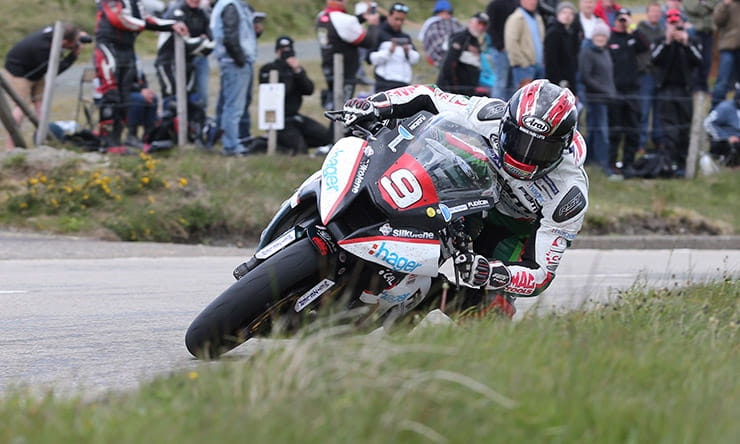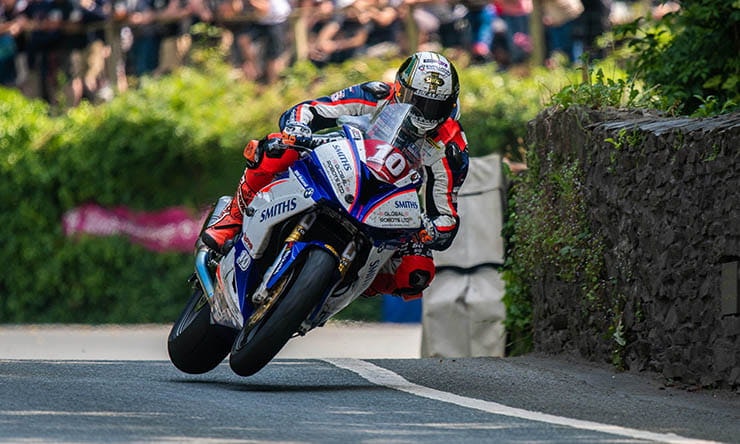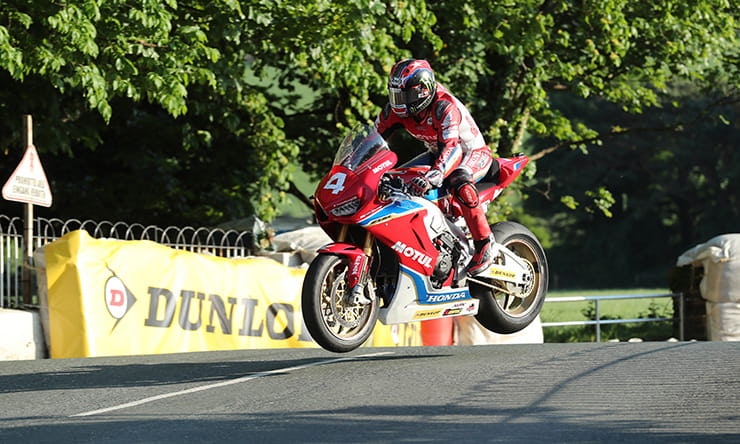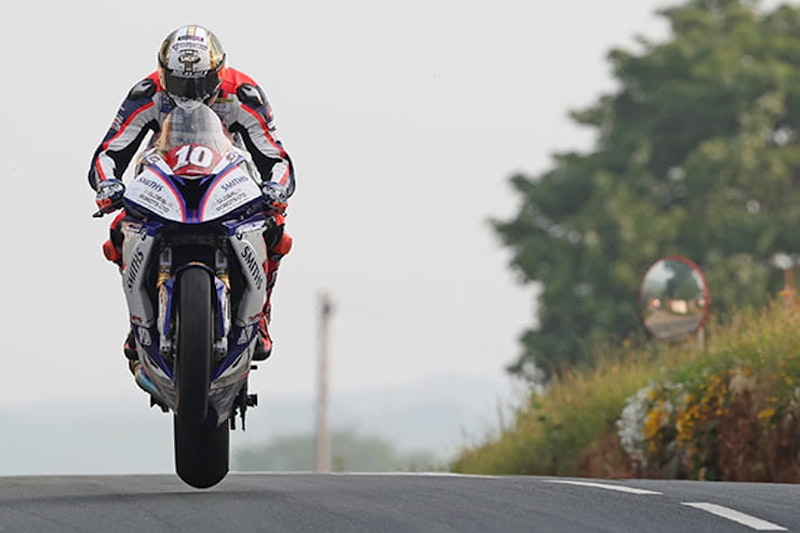Isle of Man TT 2019: New Superstock rules explained
BikeSocial Road Tester
24.05.2019
TT Superstock bikes have edged closer and closer to the Superbike counterparts, questioning – why have a superbike? Last year Peter Hickman set the outright lap record on the last lap of the Senior at, 16:42.778, 135.452mph average, but the Superstock lap record is, 16:50.601 seconds, at an average speed of 134.403mph, only eight seconds behind. Over the years Superstock rules have been legally manipulated as teams have tried to gain the upper edge – but for 2019 this is about to change.
For 2019, the TT organisers have tightened the rules, engines must remain stock - there’s no ‘mild’ engine tuning so the motors will be the same as our road bikes. Rear wheel changes during the pit stops have also been banned. How will these new rules affect the race this year?
Last year, Peter Hickman’s Smiths Racing BMW Superstock bike was only eight seconds slower than their full-power Superbike! It’s incredible to think that a bike which you or I can buy in a showroom can lap so close to a Superbike. Imagine this scenario; half-way around the TT, the stock bike is only four seconds behind, he’s still got the Superbike in sight. Four seconds is nothing, especially when you consider the Superbike is running a grippier slick tyre opposed to ‘road legal’ treaded tyres in the stock class. Many of the teams outside the top twenty simply run a Superstock bike with slicks in both the Superbike and Senior class.
Over the years we’ve witnessed a huge improvement in road bike development and teams have ‘manipulated’ Superstock rules to gain an advantage. In 2015 Ian Hutchinson, who was then onboard a Kawasaki ZX-10 for Paul Bird Motorsport, changed his rear wheel during the pit stop, as did Tyco, with Michael Dunlop at the helm. This was the first-time teams started to experiment with fast rear wheel changes on a stock bike and used ‘special’ two-lap rear tyres. Hutchy went onto win, famously nearly running out of fuel on the last lap, mounting the kerb at Bedstead as his Kawasaki spluttered on the remaining fuel.
Stuart Bland who was Hutchy’s crew chief at the time explains, “We used a softer rear tyre which simply couldn’t have done four laps. We did what we could do within the rules - machines spacers, lock-wired stuff into place, welded the washer to the nut, polished the spindle to death so it would slide in and out with ease – lots of little tricks all within the rules”.
But for 2019 the Superstock rules have been updated. Rear wheel changes are banned and the engine must remain stock. Teams are no longer allowed to ‘tinker’ with engines, motors must remain ‘as they left the showroom’. Previously you could play with cam timing and change the head gasket but now it must remain stock, like a sealed engine from the showroom. Power is increased over standard with improved fuelling via a kit ECU and obviously a race air-filter and a full race exhaust.
The new rules favour some teams but hinder others. For example; a stock Honda Fireblade is around 180bhp, whereas a new BMW S1000RR or Kawasaki ZX-10R is close to 200bhp, which means the Honda teams are already 10% down on power in the Superstock class. The new rules will also create more testing/headache for the teams.
We chatted to K-Tech Suspension, “You’ll now have to set the bike up to work with the harder four-lap tyre. It shouldn’t be a massive step as the compounds are similar, stability should be about the same. The biggest problem riders will have is edge grip on the final lap. Teams will have to do more laps in practice will need to do four laps on one tyre to see how it copes.”
We spoke to Jason Griffiths at Pirelli, himself a multiple TT podium finisher, “We have a tyre which works over four laps, some teams last year didn’t change the rear tyre and it was fine for the race distance but we also have something new for this year.”
Interestingly the Superstock kit ECU will work in partnership with the standard bikes rider aids, anti-wheelie, traction control, even launch control. Surprisingly, this means the Superstock bikes have more rider aids than the Superbikes which run BSB MoTeC electronics, which forbids any rider aids! Rider aids are permitted in the Superbike class but for cost reasons most teams will essentially ride a very similar bike to a BSB machine. Smiths Racing BMW lap record holder Peter Hickman will use the same BSB bike on the roads, which means no rider aids. Brave.
Races can be won or lost over the mountain on the final lap. As a rider, this is where you really notice the tyre wear. I raced in a Honda Fireblade in 2015 and there was a noticeable difference between a fresh tyre on lap one and a worn rear on lap four, even at my level towards the back of the grid. Silicone Engineering Kawasaki Racing, Dean Harrison explains, “Over the mountain on lap two I’m always a little slower, you can feel it spinning up as you’re asking the tyres to do a lot of work. I’ve not done for laps on a Stock tyre for a while, but we will have to in practice to see how it performs.”
When asked about the stock engines and the lack of rider aids Dean was unfazed, “That’s how it should be, stock bikes. The new Kawasaki ZX-10R is a good, the new engine revs higher so we should be good for 200bhp plus. It will only be a few bhp down on last year, and you don’t really notice a few bhp at the TT, once you’re above 200bhp. I always turn off the TC on the Superbike and the Stocker, it’s all down to me, I don’t run any electronics. But it’s interesting to see how close Stock bikes are getting to Superbikes in BSB, the lap times were close at Oulton – I image a few of them were running some TC. Obviously, in the wet, it can be an advantage, but we no longer run in the wet at the TT”
Chatting to Phil Biggs Crew Chief at Bournemouth Kawasaki explained, “James (Hillier), always runs a little traction on the Superbike, but that won’t be possible this year as we’re using the BSB spec bike. He’ll have 220bhp plus of big power on the Superbike which he has to control by himself over six laps this year, whereas on his stocker we can still add some TC.”
Last week at the North West 200 James Hiller ran his Superstock spec Kawasaki ZX-10R in the Superbike class and was in front for most the race. He was only pipped by team-mate and BSB rider Glenn Irwin on the last lap.
We also spoke to his crew chief Phil to get the data, “It was a wet race, full race wets, patchy in places. We decided to run James on the Stock bike with traction control, Glenn was on the Superbike without any. James didn’t run much traction but you could hear it kicking in and he rode cleverly, short-shifting and using the bike's torque. Through the speed trap, James was faster on the stock bike, 195.2mph compared to Glenn at 194mph on the more powerful Superbike.”
As mentioned earlier, Honda is at the biggest disadvantage with the official Honda team of Ian Hutchinson and David Johnson, and the private Padgett’s team with Conor Cummins at the helm. Arguably Suzuki is in a similar boat, the successfully run privateer team of John Burrows, Burrows Engineering/RK Racing, are the main team to stay with Suzuki. We spoke to John, himself a road racing legend, “We will run a separate Superbike for Derek McGee, and Tom Weedon will run the same Stock bike in all races. The difference between the Stock and Superbike is around 20-25bhp depending on the conditions.”
Top speeds at the North West were similar between the Superstock and Superbikes for BMW and Kawasaki but there was a noticeable difference for the Honda teams. Conor has the biggest disadvantage and he needs the power to propel his un-aerodynamic size. The tall Manxman was hitting a respectable 188-189mph on the Stock bike, but the Superbike was flying at 198.6mph. We spoke to Clive Padgett, team owner, and engine tuner, “We are about 25bhp down between the Stock and Superbike, but it’s not all about peak power. Conor did 130mph average on the stocker last year from a standing start, the Honda is an all-round proven road bike.”
The Superstock race is set to be a flyer and will no longer be won or lost in the pit-lane with a fast wheel change giving the larger team an advantage on the last lap. The Stock engine rule makes it a level playing field, easier for private teams to compete with the factory teams. We could see a privateer step forward onto the podium. But what is most important – the Superstock results will give a true reflection on the bikes we buy as customers. The bikes we see on TV are live around the TT will be running the same engine we have in our road bikes. I can’t wait to see who comes out on top, and if I was going to place a bet – I’d go for a Kawasaki or BMW.
The rule changes explained
Engine: As you’d expect very stock. Previously you could play with cam timing, change the head gasket, but now it all must remain stock, like a sealed engine from the showroom. Power is increased over standard with improved fuelling and exhaust. A good Superstock bike is usually around 200-210bhp, but it might be slightly less this year.
Chassis/suspension: The frame remains stock, but you can change the rear shock and fork internals. Rear shock linkage must remain stock. Semi-active suspension is allowed, if it comes on the bike as standard. Teams have experimented with semi-active suspension but it’s still new and unproven at the TT.
Wheels and brakes: You can change the brake discs and the pad materials, but the calipers must remain stock. Thumb brakes are allowed but you must retain the standard master cylinder. ABS is obviously removed. Wheels are stock and treaded ‘road legal’ rubber must be used.
Bodywork: Obviously all standard bodywork is removed, and it must retain the silhouette of the standard road bike. The fuel tanks increase in size, but can’t be more than 24l. Bars, pegs and all the usual stock items can be replaced with race items.
Electronics: Factory ECU which can work in partnership with any standard rider aids. The only permitted addition is a pit-lane limiter.
Bikes
BMW S1000RR (old and new)
Honda Fireblade SP
Kawasaki ZX-10R
Suzuki GSX-R1000
Yamaha YZF-R1M
Rules
Over 600cc and up to 1000cc 4-stroke 4-cylinders
Over 750cc and up to 1000cc 4-stroke 3-cylinders
Over 850cc and up to 1200cc 4-stroke 2-cylinders
Modifying capacity to reach class limits is not permitted
No engine modifications permitted
Fuel capacity: 24 litres max
Minimum weight 174kg
Tyres: treaded; warmers allowed
Photos:www.iomttraces.com
Share on social media:



